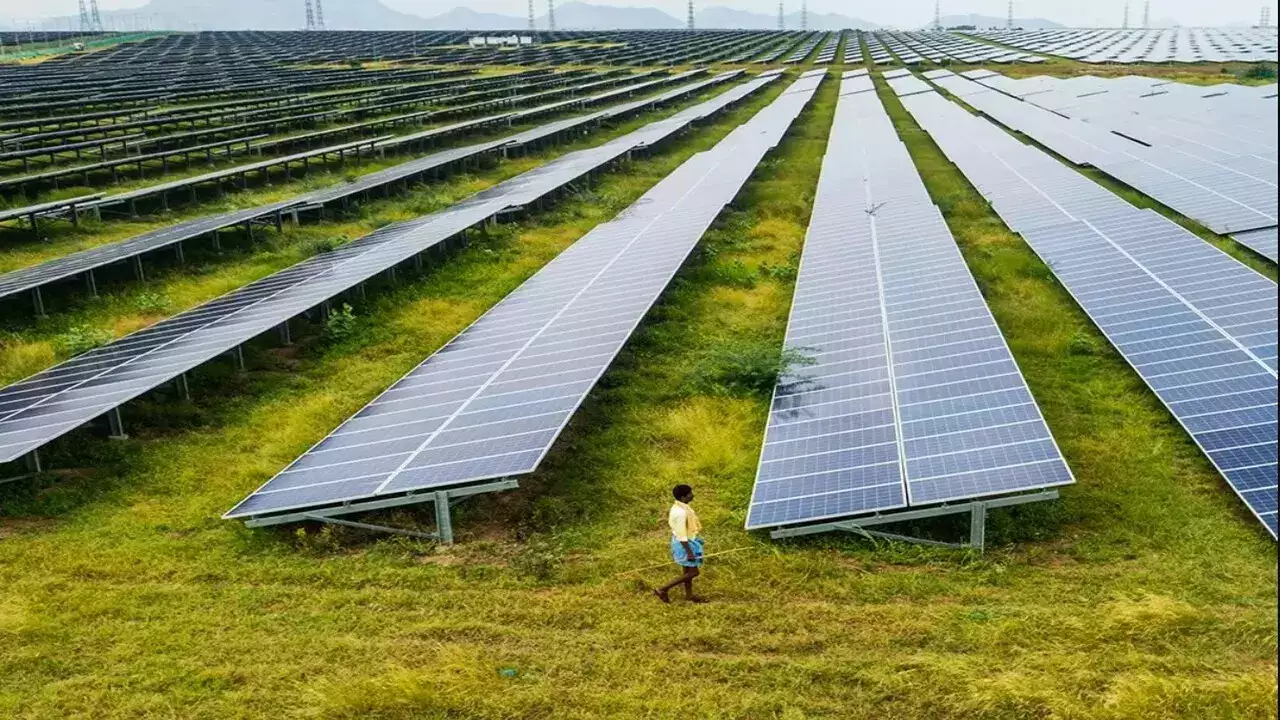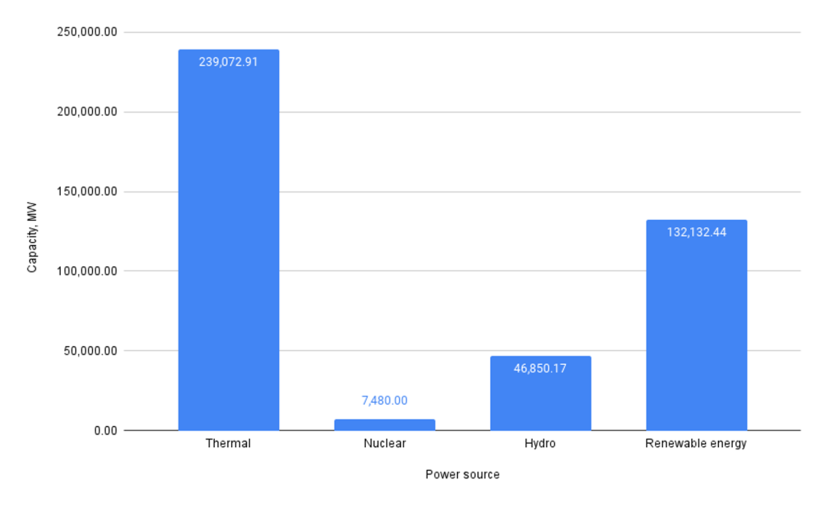Description

Copyright infringement not intended
Picture Courtesy: www.timesnownews.com
Context: India is pushing for more renewable energy like solar and wind, but it's facing challenges with intermittency (generation only when it's sunny or windy) and a lack of viable energy storage options.
Details
- The final climate deal that was reached at COP 28 did not include a provision that would have required new coal-fired power plants to have carbon capture and storage technology.
- This was the result of strong opposition from India and some other countries, such as China and South Africa, who argued that such a requirement would limit their energy options and impose an unfair burden on developing nations.
- The stance taken by India and other nations against the inclusion of mandatory Carbon capture and storage (CCS) for new coal plants at COP28 reflects a multifaceted perspective on addressing climate change.
Reasons for Pushback
- Cost and Viability: Affordability remains a significant concern, especially for developing countries where resources might be constrained. The additional expenses related to implementing CCS could make coal plants economically unviable.
- Technical Challenges: The developmental stage of CCS technology, coupled with its inefficiencies and scalability issues, poses practical challenges in its widespread application.
- Resource Allocation: Prioritizing CCS might divert resources from developing more mature and economically feasible renewable energy technologies, potentially slowing down the transition to cleaner energy sources.
- Developmental Needs: Nations like India stress the requirement for reliable energy to support their economic growth. They perceive coal, with or without CCS, as a necessary bridge while investing in renewable alternatives.

Implications of Omission
- Emissions Reduction Missed Opportunity: The exclusion of CCS from the final deal limits the potential for capturing and storing substantial CO2 emissions from coal plants, affecting the overall ambition for emission reduction.
- Continued Fossil Fuel Reliance: The absence of immediate restrictions allows countries to proceed with new coal plant constructions, which might impede the global shift towards clean energy.
- Pressure on Existing Plants: The focus could shift to retrofitting existing coal plants with CCS, a complex and costly endeavour.
Possible Future Scenarios
- Technological Progress: Advancements in CCS technology might render it more economically viable and efficient, altering future considerations for international agreements.
- Market Influences: Increased pressure from stakeholders and rising fossil fuel costs might accelerate the transition towards renewable energy sources.
- International Collaboration: Collaborative efforts between developed and developing nations could drive the development and deployment of more affordable CCS technology, facilitating a more equitable global transition.
India’s New Coal Thrust
- India's recent decision to increase its coal-powered generation capacity, aiming to add 80 gigawatts (GW) of coal power by 2031-32, marks a substantial departure from India's previous emphasis on renewable energy sources.
- The government argues that coal is essential for India’s economic growth and energy security and that it will use advanced technologies to minimize the impact of coal burning.
- However, critics say that coal is a dirty and outdated source of energy and that India should invest more in renewable energy and energy efficiency. They also warn that coal mining will displace millions of people, destroy forests and wildlife habitats, and pollute water and air.

Key Policy change
- Increased Coal Capacity: The planned addition of 80 GW of coal power represents a substantial boost from current levels, suggesting a move away from the prior emphasis on renewable energy as the primary source of new capacity.
- Policy Reversal: This decision signifies a significant policy shift, steering away from the earlier focus on promoting renewables. It aligns with the government's perceived need for reliable baseload power, an area where coal plants historically excel compared to solar or wind.
- Baseload Power: Coal plants are known for providing consistent baseload power, a factor crucial for a country experiencing rapid industrial and economic growth. This reliability is a primary driver behind India's shift towards coal.
- Additional Capacity: On top of the 80 GW target, India aims to add another 60 GW of fresh coal capacity to the existing 27 GW under construction, further amplifying its coal-powered energy generation.

Reasons for the Shift
- Energy Security Concerns: Global energy price hikes and potential supply chain disruptions have heightened concerns about energy security. Coal, available domestically, offers a measure of stability in this volatile landscape.
- Challenges with Renewables: Integrating large-scale renewable energy into the grid necessitates substantial investments in storage and transmission infrastructure, which are still in the developmental stage. Coal power offers a quicker and more seamless integration into the existing grid.
- Cost and Affordability: Coal remains a cost-effective and easily accessible fuel source, especially for developing nations like India. This affordability makes it an attractive option for meeting immediate energy needs.
- Industrial and Economic Growth: India's rapid economic growth fuels an increasing power demand. Coal's capacity to quickly provide substantial baseload power supports this growth.
Potential Concerns
- Environmental Impact: Coal combustion is a significant contributor to greenhouse gas emissions and air pollution, exacerbating climate change and posing health risks for communities near coal plants.
- Sustainability Concerns: Reliance on coal could impede the progress and adoption of cleaner and more sustainable energy sources in the long term.
- Public Health: Air pollution stemming from coal plants can have severe health consequences for nearby communities, posing significant health risks.
Balancing the Needs
- Investing in Clean Coal Technologies: Adoption of technologies like carbon capture and storage can help mitigate the environmental impact of coal-powered plants.
- Promoting Renewable Energy: Continued investment in renewable sources like solar and wind remains crucial for achieving long-term sustainability goals.
- Improving Energy Efficiency: Reducing energy consumption across sectors can significantly decrease overall power demand, irrespective of the source
Problem with renewable
- India has made significant strides in renewable energy, becoming the world's third-largest producer with over 40% of its installed capacity coming from non-fossil fuels. However, this green push has come with a challenge: intermittency.
- The intermittency challenge poses a significant obstacle to India's ambitious renewable energy agenda. While the country has made commendable progress in becoming a global renewable energy leader, the reliance on weather-dependent sources like solar and wind has introduced a critical hurdle: unpredictability in power generation.
Understanding Intermittency
- Renewable sources, such as solar and wind, generate electricity based on varying weather conditions. This leads to fluctuating power outputs—high during optimal conditions and low during adverse weather. The resulting challenges include:
- Mismatched Generation and Demand: The irregular nature of renewable power can cause surges or drops in generation that don't always align with the times of peak demand. This mismatch can strain grid stability.
- Grid Instability: The sudden shifts in power output can destabilize the grid, potentially causing disruptions in the electricity supply, and leading to outages or blackouts.
Impact on India's Energy Landscape
- Increased Costs: To ensure grid stability despite renewable intermittency, utilities maintain standby thermal plants, incurring high fixed costs. This additional expense often makes renewable power seem more expensive than anticipated.
- Discom Hesitancy: State-owned distribution companies are hesitant to solely rely on renewables due to their unpredictability. This reluctance impedes a smooth transition to clean energy.
- Necessity for Grid Modernization: The current grid infrastructure isn't optimized to efficiently handle the variability of renewable energy. Upgrading the grid becomes imperative to effectively integrate renewable sources.
Potential Solutions
- Energy Storage: Investments in large-scale energy storage systems, like battery storage, can capture surplus renewable energy during peak generation periods and release it when demand is high or generation is low, thereby stabilizing supply.
- Demand-Side Management: Encouraging consumers to adjust their energy consumption patterns, especially during peak and off-peak hours, can help align energy supply with demand more effectively.
- Grid Modernization: Upgrading the grid infrastructure with smart technologies and advanced forecasting systems can enhance grid flexibility and better manage the variability of renewable energy sources.
Storage Problem
- The recent decision to increase coal generation capacity reveals a stark reality: India's ambitious renewable energy push is facing a critical roadblock – energy storage. While the rapid growth of solar and wind power is commendable, their dependence on weather makes them inherently variable, creating challenges for grid stability.
Storage Challenge
- Renewable Variability: Solar and wind power output fluctuates due to weather conditions. This unpredictability poses challenges, potentially disrupting grid stability, and causing blackouts as renewables occupy a larger share of the energy mix.
- Storage Challenges: Existing storage technologies, notably Lithium-ion batteries, are expensive and unsuitable for large-scale grid applications. Alternatives like hydrogen and hybrid models are promising but are still in developmental stages, lacking commercial viability.
- Discom Constraints: State-owned distribution companies encounter hurdles integrating variable renewables due to inflexible power purchase agreements (PPAs). This lack of adaptability stifles innovation in grid management.
- Coal Dependency: Policymakers foresee a temporary reliance on coal-fired plants for base load demand due to the absence of effective storage solutions. Constraints in expanding nuclear capacity further contribute to this reliance.
- Cost Concerns: The significant investment required for storage infrastructure is a major apprehension. Estimates suggest a substantial financial commitment, ranging from Rs 5-8 lakh crore solely for battery storage over the next decade, covering a fraction of daily usage.
Possible Solutions and Challenges
- Developing Efficient Storage: Investing in research and government support to explore cost-effective storage solutions like hydrogen and pumped storage is critical. Bringing down costs and enhancing efficiency is essential for scalability.
- PPA Modernization: Revisiting existing power purchase agreements with renewable developers to allow more flexibility is crucial. This adaptability would empower discoms to integrate variable energy sources effectively.
- Grid Modernization: Upgrading the grid with smart technologies and advanced forecasting systems improves resilience to renewable generation fluctuations, bolstering grid stability.
- Balancing Short-term and Long-term Goals: While short-term reliance on coal for base load may be necessary, the focus must remain on long-term decarbonization and transitioning to a renewable energy future.

Conclusion
- India's shift towards increased coal capacity represents a multifaceted challenge with no easy solutions. While it may address immediate energy security concerns, it raises significant environmental and health issues. To secure a sustainable energy future, the government must balance immediate needs with long-term commitments to clean energy and environmental health through careful planning and implementation strategies.
Must Read Articles:
COP28: https://www.iasgyan.in/daily-current-affairs/cop28
COP 28: Triple nuclear capacity by 2050: https://www.iasgyan.in/daily-current-affairs/cop-28-triple-nuclear-capacity-by-2050
|
PRACTICE QUESTION
Q. How can India strike a balance between its ambitious green push and the economic considerations to ensure sustainable development and address the energy needs of its growing population?
|

















